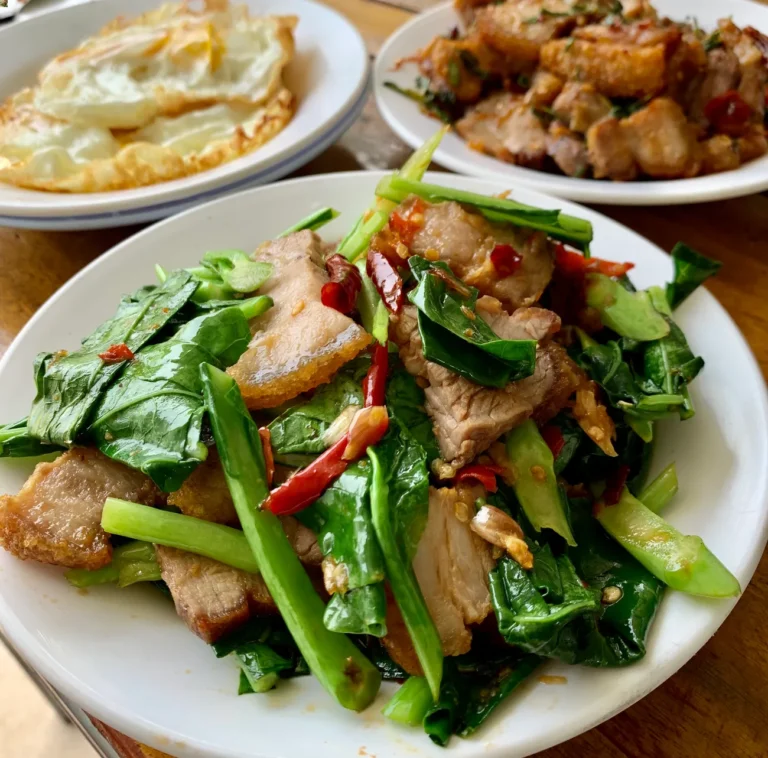Thai Chili Flakes (Prik Bon)
As an Amazon Associate, I earn from qualifying purchases. Read the full disclosure here .
Learn how to make Thai chili flakes (prik bon) in just 10 minutes! The secret is roasting the chilies first to bring out a smoky note that’s so much better than anything store-bought.

In Thailand, every kitchen has a jar of Thai chili powder! It’s a classic table condiment, just like chili oil and prik nam pla, for adding instant heat and flavor to any dish.
Thai chili flakes are made by dry-roasting dried Thai chilies and grinding them into coarse flakes. They add heat and a smoky flavor to dishes. The spiciness depends on the type of chilies used, with bird’s eye chilies being especially hot.
What type of chilies should you use?
You’ll need dried chilies for this recipe. I grow fresh chili peppers myself and sun-dry them, but you can easily find dried chilies at any Asian grocery store or market.

You can use any type of dried chili to make chili pepper flakes, your choice depends on how spicy you want it. Some chilies are mild, while others are really spicy. Here are some popular choices:
- Thai bird’s eye chilies (prik kee noo) – Very spicy and perfect if you want intense heat. These are often used in Thai stir-fries, dipping sauces, and salads.
- Thai spur chilies (prik chee fa) – Milder with a vibrant red color and subtle warmth. These are also used to make red curry paste, and are great for mild-medium spicy flakes.
- Thai jinda chilies – Moderately hot and often used for a balanced heat. These are my favorites.
- Chile de árbol – Not Thai, but similar in heat to jinda or spur chilies, and a good substitute if that’s what you have on hand.
Tip: If your dried chilies are too spicy, simply split them open and remove the seeds before roasting. This reduces the heat while keeping the flavor.

How to make Thai chili flakes
Step 1: Remove the stems and place the dried chilies in a dry pan or cast iron skillet over low heat. Roast them gently, stirring constantly to prevent burning. You’ll notice the chilies darken slightly and release a smoky aroma, this is where all that depth of flavor comes from. Keep your windows open or roast outside if possible, as the fumes can be intense. No oil needed!
Step 2: Once the chilies are roasted, take them off the heat and set them aside to cool completely. You can use a fan to speed things up. Don’t skip this step, grinding hot chilies can cause moisture buildup and affect texture.
Step 3: Use a mortar and pestle or food processor to crush or grind the roasted chilies into dried chili flakes. You can keep them coarse or grind them into a fine powder, depending on your preference.
Tips for making prik bon
- Kitchen gloves: Wear kitchen gloves when handling chilies to avoid skin irritation or accidentally touching your eyes. I learned the hard way while working at Thai restaurants!
- Storage: Keep your homemade chili flakes in an airtight jar, stored in a cool, dry place. They’ll stay fresh and full of flavor for months, some even say up to a year!
- How to use: Sprinkle prik bon over soups, noodles, stir-fries, or Thai salads. It adds instant heat and that signature roasted chili flavor we Thai people love.
More Thai condiments you’ll love
You can buy pre-made dried Thai chili flakes, but homemade prik bon is so worth it! Making them at home means you control the spice level and skip all the additives. Follow me on social media: Facebook, Instagram, and Pinterest.
Thai Chili Flakes Recipe (Prik Bon)

Equipment
- mortar and pestle or food processor
Instructions
- Remove the stems from the dried chilies. Roast them in a frying pan or cast-iron skillet over low heat. Stir continuously to prevent them from burning. For ventilation, it’s a good idea to open your windows or consider doing this step outside. Don’t add oil to the pan; the chilies will release their natural oils, enhancing their aroma. The peppers will darken slightly as they roast.
- Once roasted, take the chilies off the heat and allow them to cool completely. You can use a fan to speed things up. This step is crucial before you move on to grinding them.
- To make Thai dried chili flakes, I like to use a mortar and pestle to pound the roasted chilies. Crush them into a fine powder or leave them in chunkier bits, depending on your preference. If you prefer a quicker method, use a spice grinder. Just pulse the chilies until you reach the desired texture. Remember, the longer you blend or grind, the finer the flakes will be!
Notes
- Use the nutrition card in this recipe as a guideline.






